- Alocasia Care Tips: How to Keep Your Alocasia Plant Healthy
- Light requirements
- Temperature and humidity
- Watering
- Soil and fertilization
- Pruning and repotting
- Pest control
- Common issues
- Conclusion
- Choosing the Right Location for Your Alocasia
- 1. Light Requirements
- 2. Temperature
- 3. Humidity
- 4. Air Circulation
- 5. Space
- 6. Toxicity
- 7. Soil and Pot Selection
- Conclusion
- Proper Watering Techniques for Alocasia Plants
- 1. Watering Frequency
- 2. Watering Technique
- 3. Water Quality
- 4. Drainage
- 5. Humidity
- 6. Signs of Overwatering
- 7. Signs of Underwatering
- Humidity Requirements for Alocasia: Creating the Perfect Environment
- Why is humidity important for Alocasia?
- How to increase humidity for Alocasia plants
- Monitoring humidity levels
- Conclusion
- Alocasia Plant Food: Nourishing Your Plants for Optimal Growth
- 1. Choose a balanced fertilizer
- 2. Feed your plants regularly
- 3. Adjust feeding schedule during dormant period
- 4. Apply fertilizer to moist soil
- 5. Avoid over-fertilizing
- 6. Use organic fertilizers
- In conclusion
- Alocasia Propagation: How to Multiply Your Plants
- Division
- Offsets
- Stem Cuttings
- Common Alocasia Pests and Diseases: Identify and Treat the Problems
- 1. Spider Mites
- 2. Mealybugs
- 3. Aphids
- 4. Root Rot
- 5. Leaf Spot
- Alocasia Plant Varieties: Explore the Stunning Photos
- Alocasia Amazonica
- Alocasia Polly
- Alocasia Zebrina
- Popular Alocasia Species: An Overview of Different Types
- Alocasia Polly (Alocasia × amazonica)
- Alocasia Wentii
- Alocasia Regal Shields
- Alocasia Macrorrhizos (Giant Elephant Ear)
- Alocasia Borneo Giant
- Alocasia Frydek (Alocasia micholitziana)
- Q&A:
- What is Alocasia?
- What are some popular species of Alocasia?
- How do I take care of an Alocasia plant?
- What is the best way to propagate Alocasia?
- Can Alocasia plants be grown indoors?
- What are some common problems that Alocasia plants face?
- What are some tips for keeping Alocasia plants looking their best?
- Video: OXALIS CARE TIPS – Plant Spotlight #oxalistriangularis
If you are a plant enthusiast looking to add a touch of exotic beauty to your indoor garden, then Alocasia plants might be the perfect choice for you. Known for their striking foliage and unique shapes, Alocasia plants have become increasingly popular in recent years. In this guide, we will explore everything you need to know about caring for Alocasia plants, as well as provide stunning photos and a guide to popular Alocasia species.
Alocasia plants, also commonly known as elephant ears or African masks, are native to tropical regions of Asia. With their large, vibrant leaves that resemble elephant ears, these plants can make a bold statement in any space. However, it’s important to note that Alocasia plants require a bit more care compared to other houseplants, so it’s essential to understand their specific needs.
To keep your Alocasia plant thriving, it’s vital to provide it with the right conditions. These plants prefer bright, indirect light and moderately moist soil. It’s important to avoid overwatering, as this can lead to root rot. Additionally, Alocasia plants thrive in humid environments, so misting their leaves or placing them near a humidifier can help create the perfect conditions.
In this article, we will take a closer look at some popular Alocasia species, including the Alocasia Amazonica, Alocasia Polly, and Alocasia Zebrina. We will discuss their unique features, care requirements, and show you stunning photos that showcase their beauty. Whether you are a beginner or an experienced plant parent, this guide will provide you with all the information you need to successfully care for and enjoy your Alocasia plants.
“Alocasia plants can add a touch of exotic beauty to any indoor garden, with their striking foliage and unique shapes.”
Alocasia Care Tips: How to Keep Your Alocasia Plant Healthy
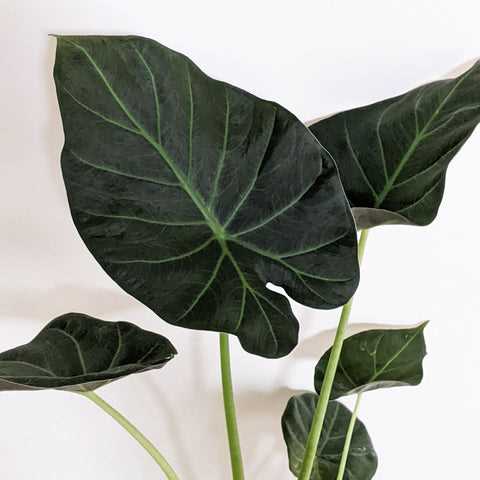
Light requirements
Alocasia plants prefer bright, indirect light. Place your plant near a window where it can receive bright, filtered light. Avoid placing it in direct sunlight, as this can scorch the leaves of the plant.
Temperature and humidity
Alocasia plants thrive in warm and humid environments. The ideal temperature range for these plants is between 65°F and 85°F (18°C – 29°C). Maintain a humidity level of around 60% to 80% to keep your Alocasia happy. You can increase humidity by placing a tray of water near the plant or using a humidifier.
Watering
Be careful not to overwater your Alocasia. Allow the top inch of the soil to dry out before watering again. Water thoroughly, ensuring that excess water drains out of the pot. Avoid letting the plant sit in standing water, as this can lead to root rot.
Soil and fertilization
Use well-draining soil for your Alocasia plant. A mixture of peat moss, perlite, and potting soil works well. Fertilize your plant every 2-4 weeks during the growing season using a balanced, water-soluble fertilizer. Follow the manufacturer’s instructions for dosage.
Pruning and repotting
Prune any yellow or damaged leaves to maintain the overall health and appearance of your plant. Repot your Alocasia every 1-2 years to provide fresh soil and room for growth. Choose a pot that is slightly larger than the current one, and ensure it has drainage holes.
Pest control
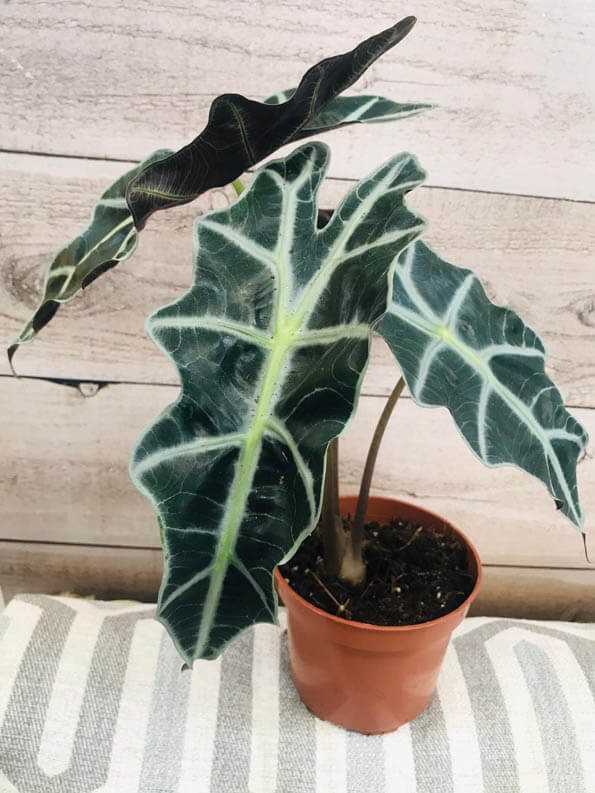
Keep an eye out for common pests such as aphids, spider mites, and mealybugs. If you notice any signs of infestation, isolate the affected plant and treat with an appropriate insecticide or insecticidal soap according to the product instructions.
Common issues
Alocasia plants can suffer from several common issues. Leaf yellowing may indicate overwatering or underwatering, while brown tips can be a sign of low humidity. Wilting leaves can be a result of underwatering or cold drafts. Adjust your care routine accordingly to address these problems.
Conclusion
By providing the right conditions such as proper lighting, temperature, humidity, watering, soil, and regular maintenance, you can ensure the health and happiness of your Alocasia plant. Remember to observe your plant closely and make adjustments as needed to keep it thriving for years to come.
Choosing the Right Location for Your Alocasia
When it comes to growing Alocasia plants, choosing the right location is crucial for their health and growth. Here are some factors to consider when selecting a spot for your Alocasia:
1. Light Requirements
Alocasias thrive in bright, indirect light. Too much direct sunlight can scorch their leaves, while too little light can result in slow growth or leggy stems. Place your Alocasia in a spot where it receives bright, filtered light.
2. Temperature
Alocasias prefer warm and tropical environments. They thrive in temperatures ranging from 60 to 85 degrees Fahrenheit (15 to 29 degrees Celsius). Avoid placing your Alocasia in drafty or cold areas, as it can cause stress and harm the plant.
3. Humidity
Alocasias love high humidity levels. They are native to rainforests, where humidity is typically high. To create a suitable environment for your Alocasia, you can mist the leaves regularly, use a humidifier, or place the plant on a tray filled with water and pebbles.
4. Air Circulation
While Alocasias enjoy humidity, they also need good air circulation. Stagnant air can lead to fungal diseases and pest infestations. Make sure the area where you place your Alocasia has adequate airflow, or consider using a fan to promote healthy growth.
5. Space
Alocasias can grow quite large, with some species reaching several feet in height. Ensure that you have enough space to accommodate the mature size of your Alocasia. This includes considering the width of the plant as well, as it can have a spreading growth habit.
6. Toxicity
Keep in mind that Alocasias are toxic to humans and animals if ingested. If you have pets or small children, it is important to place your Alocasia in a location where it is out of reach to prevent any accidents.
7. Soil and Pot Selection
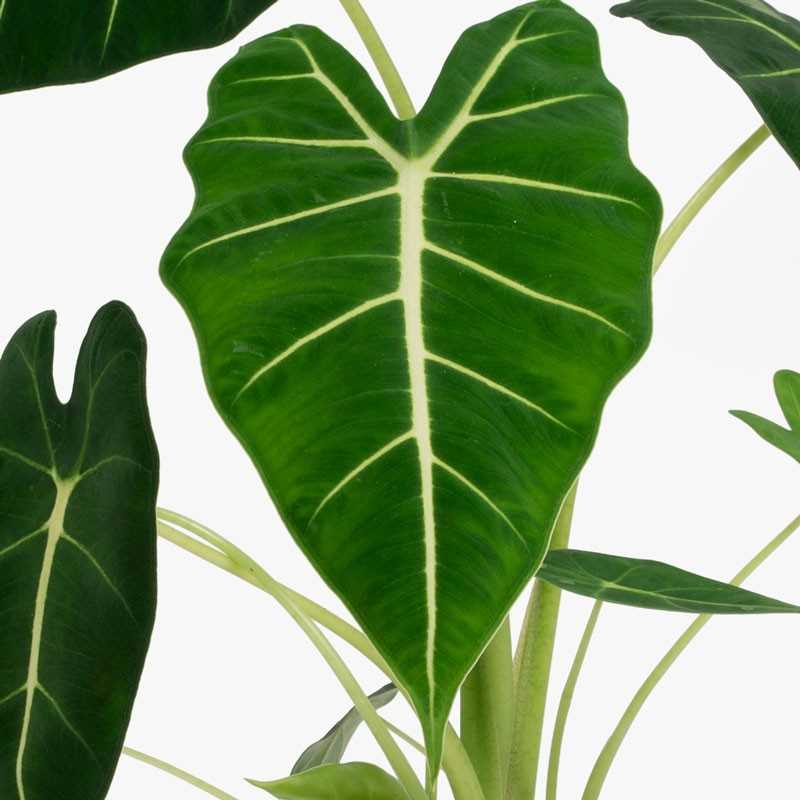
Alocasias prefer well-draining soil that retains moisture without becoming waterlogged. Choose a pot with drainage holes to prevent overwatering and root rot. Additionally, select a pot that is slightly larger than the current root ball to allow room for growth.
Conclusion
By considering the light requirements, temperature, humidity, air circulation, space, toxicity, and soil and pot selection, you can choose the perfect location for your Alocasia. Providing the right conditions will ensure that your Alocasia stays healthy and thrives in its environment.
Proper Watering Techniques for Alocasia Plants
Alocasia plants are tropical plants that require specific watering techniques to thrive. Improper watering can lead to root rot or dehydration, which can be fatal to the plant. Follow these tips to ensure your Alocasia plants receive the proper amount of water:
1. Watering Frequency
It is important to establish a watering schedule for your Alocasia plants to maintain consistent moisture levels. Water them thoroughly when the top inch of soil feels dry to the touch. However, make sure not to overwater, as this can lead to root rot.
2. Watering Technique
When watering your Alocasia plants, pour water directly onto the soil rather than on the leaves or stems. This will ensure that the roots receive the water they need and reduce the risk of fungal infections on the foliage.
3. Water Quality
Use room temperature water when watering your Alocasia plants. Avoid using water that is too cold or too hot, as extreme temperatures can shock the roots and cause stress to the plant.
4. Drainage
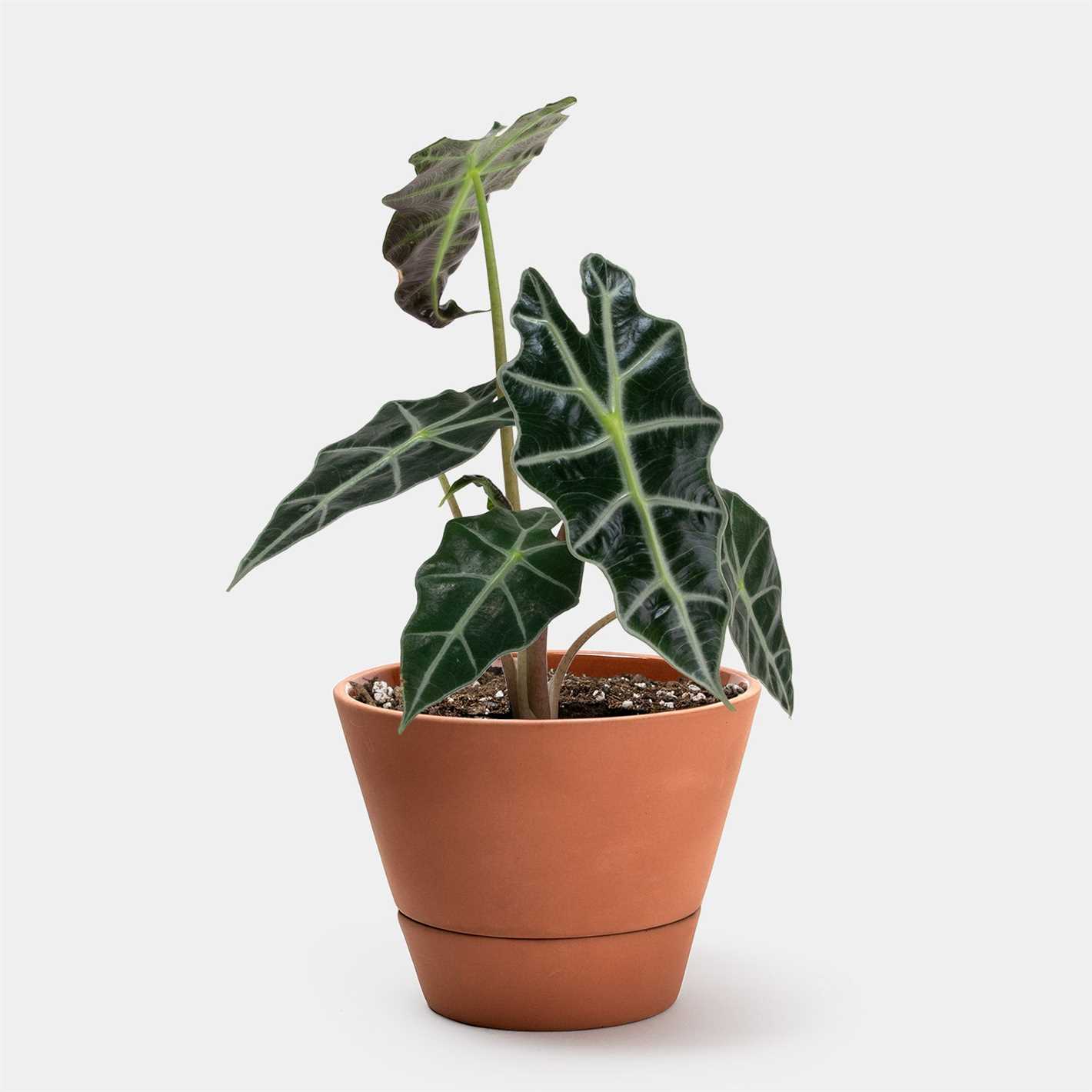
Good drainage is essential for Alocasia plants. Make sure that the pot has drainage holes to allow excess water to escape. If the pot does not have drainage holes, consider repotting the plant into a container that does.
5. Humidity
Alocasia plants thrive in high humidity environments. To increase humidity levels, you can place a tray filled with water near the plant or use a humidifier. Mist the leaves of the plant occasionally to provide extra moisture.
6. Signs of Overwatering
Overwatering can be detrimental to Alocasia plants. If you notice yellowing leaves, wilting, or a foul smell coming from the soil, it may indicate that the plant is receiving too much water. Adjust your watering schedule accordingly.
7. Signs of Underwatering
Underwatering can also harm Alocasia plants. If you notice drooping leaves, dry and brittle foliage, or the plant feels lightweight, it may indicate dehydration. Increase your watering frequency and adjust the amount of water you provide.
By following these proper watering techniques, you can help your Alocasia plants thrive and enjoy their stunning foliage for years to come.
Humidity Requirements for Alocasia: Creating the Perfect Environment
Humidity is an important factor to consider when caring for Alocasia plants. These tropical plants thrive in high humidity environments, much like their natural habitat in the rainforests of Southeast Asia. In order to create the perfect environment for your Alocasia, it is important to maintain the right level of humidity.
Why is humidity important for Alocasia?
Alocasia plants have large, lush foliage that requires high humidity to thrive. Higher humidity levels help to keep the leaves moisturized, preventing them from drying out and becoming crispy. Adequate humidity also promotes healthy growth and prevents the plant from becoming stressed or developing problems like brown leaf tips.
How to increase humidity for Alocasia plants
There are several ways to increase humidity for your Alocasia plants:
- Misting: Regularly misting the leaves of your Alocasia plant with water can help increase humidity around the plant.
- Humidifier: Using a humidifier in the room where your Alocasia is located can provide a constant source of humidity.
- Pebble tray: Placing the plant on a tray filled with pebbles and water creates a humid microenvironment around the plant.
- Bathroom or kitchen: Alocasia plants can benefit from the higher humidity levels typically found in bathrooms and kitchens.
Monitoring humidity levels
In order to ensure that the humidity levels are suitable for your Alocasia, it is important to monitor them regularly. You can use a hygrometer, a device that measures humidity, to keep track of the humidity levels in the room where your Alocasia is located. The ideal humidity range for Alocasia plants is between 60% and 80%.
Conclusion
Providing the right humidity levels is vital for the health and well-being of your Alocasia plants. By following the tips outlined above, you can create a perfect environment that replicates the high humidity conditions these plants thrive in.
Alocasia Plant Food: Nourishing Your Plants for Optimal Growth
Proper nutrition is essential for the optimal growth and health of Alocasia plants. By providing your plants with the right nutrients, you can ensure that they grow strong, vibrant, and more resistant to diseases and pests. Here are some tips on how to nourish your Alocasia plants:
1. Choose a balanced fertilizer
Alocasia plants benefit from a balanced fertilizer that contains equal parts of nitrogen, phosphorus, and potassium (N-P-K). Look for a fertilizer with an N-P-K ratio of 10-10-10 or 20-20-20. This balanced fertilizer will provide your plants with the necessary essential nutrients for healthy growth.
2. Feed your plants regularly
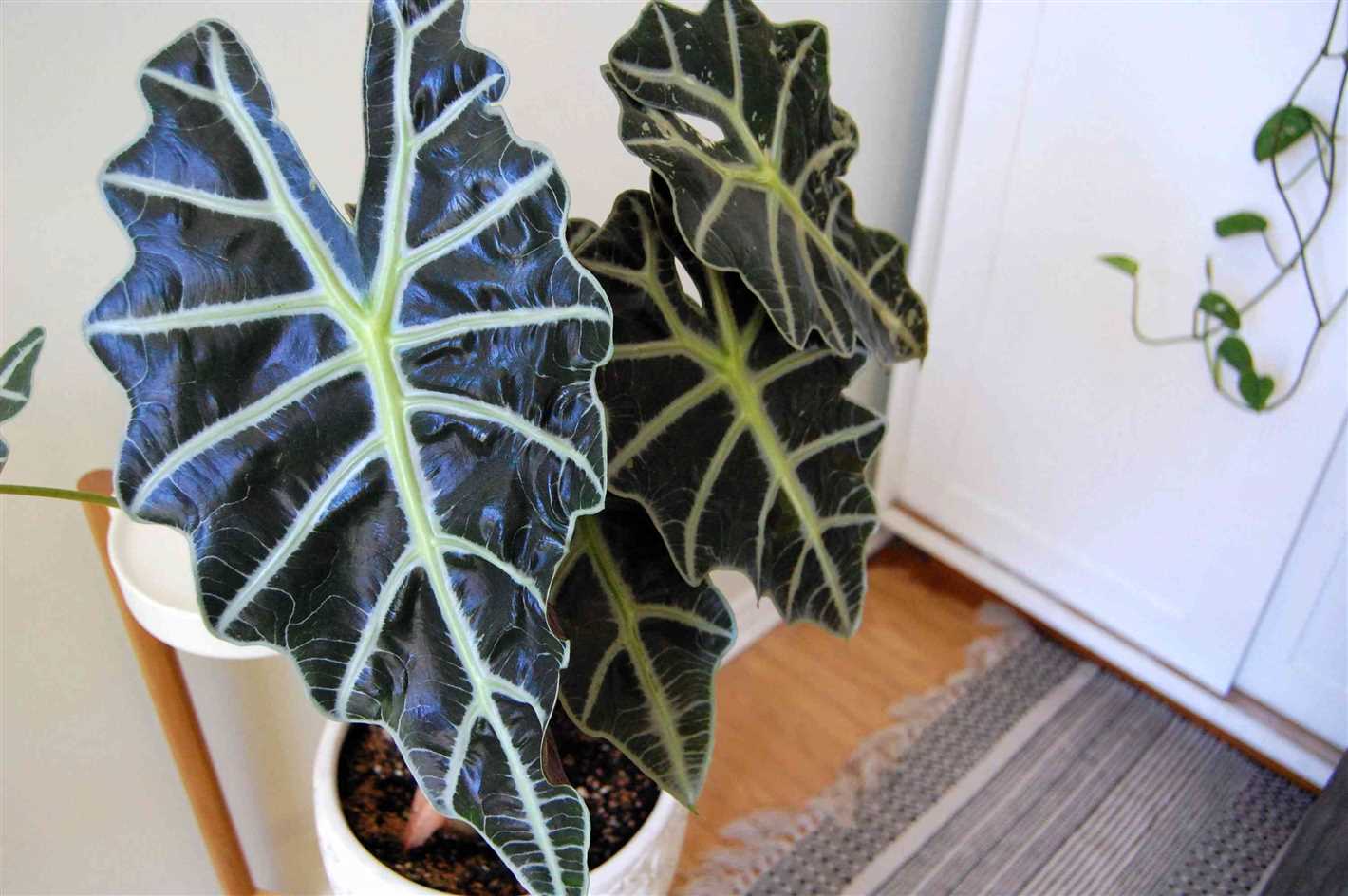
During the active growing season, which typically occurs in spring and summer, feed your Alocasia plants every two to four weeks. Dilute the fertilizer according to the instructions on the package, and water your plants thoroughly before applying the fertilizer to avoid burning the roots.
3. Adjust feeding schedule during dormant period
During the dormant period, which usually takes place in fall and winter, reduce the frequency of feeding. Feed your Alocasia plants only once a month or every six weeks. This will provide them with the necessary nutrients to sustain their growth during this resting phase.
4. Apply fertilizer to moist soil
Always apply fertilizer to moist soil to avoid damaging the roots. Water your Alocasia plants thoroughly before applying the fertilizing solution. This will help the nutrients to dissolve and distribute evenly in the soil, ensuring that your plants can readily absorb them.
5. Avoid over-fertilizing
Over-fertilizing can harm your Alocasia plants, leading to fertilizer burn or nutrient imbalances. Follow the instructions on the fertilizer package and avoid applying more fertilizer than recommended. If in doubt, it’s better to under-fertilize than over-fertilize.
6. Use organic fertilizers
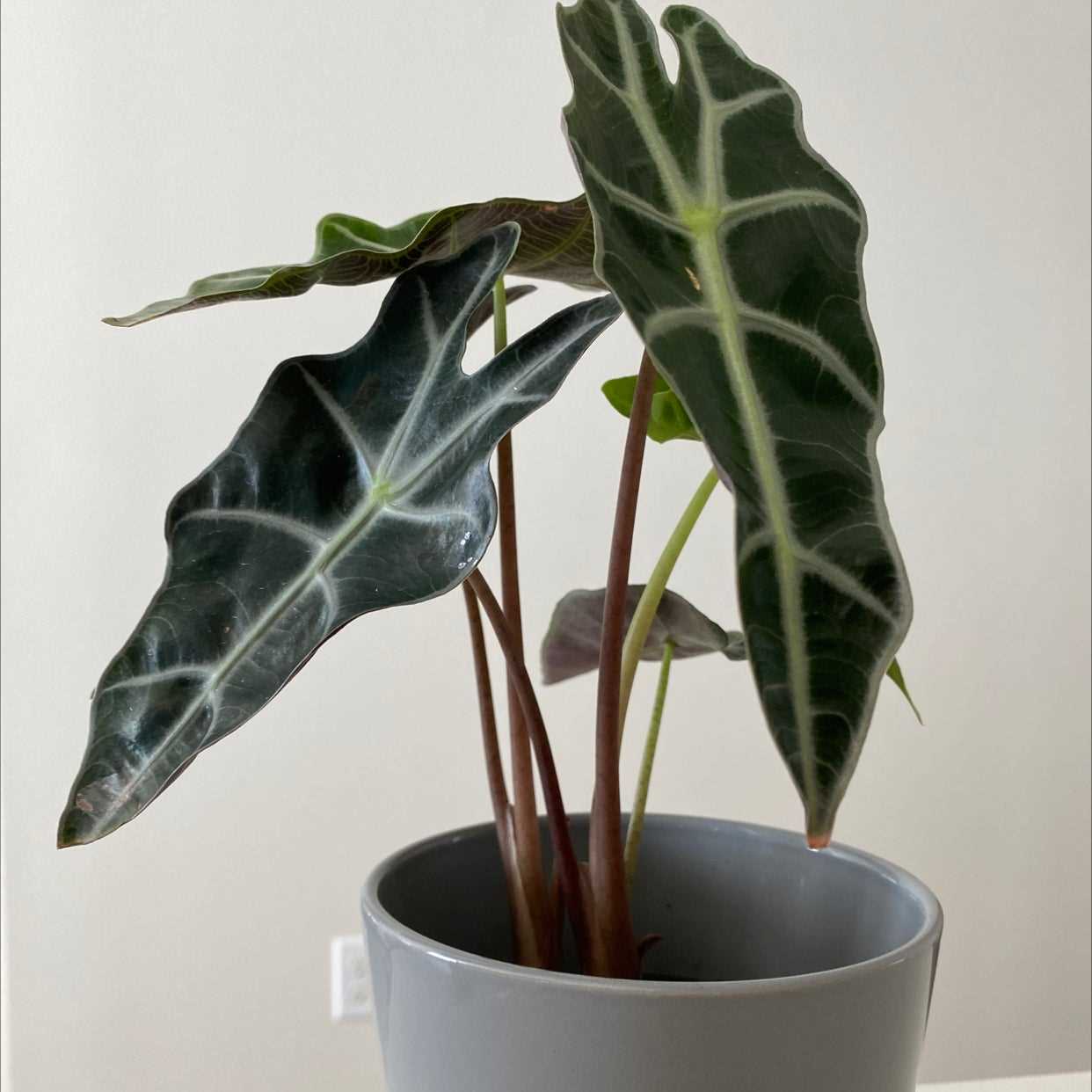
If you prefer an organic approach to plant care, consider using organic fertilizers such as compost or worm castings. These natural fertilizers provide slow-release nutrients and improve the overall health of the soil, promoting long-term growth and vitality of your Alocasia plants.
In conclusion
Nourishing your Alocasia plants with the right plant food is crucial for their optimal growth and overall health. Follow these tips to provide your plants with the necessary nutrients and enjoy their beauty for years to come.
Alocasia Propagation: How to Multiply Your Plants
Propagation is an excellent way to multiply your Alocasia plants and expand your collection. There are several methods you can use to propagate Alocasia, including division, offsets, and stem cuttings.
Division
Division is one of the most common and straightforward methods of propagating Alocasia plants. Here’s how you can do it:
- Prepare a clean, sharp knife or garden shears.
- Gently remove the plant from its pot, being careful not to damage the roots.
- Inspect the rhizome (the thick, horizontal stem) and identify any visible divisions or offsets.
- Use the knife or shears to carefully separate the divisions from the main rhizome. Make sure each division has its own roots.
- Plant each division in a separate container with well-draining soil, making sure the roots are covered.
- Water the newly potted divisions thoroughly and place them in a warm, bright location, away from direct sunlight.
- Continue to care for the divisions as you would for a mature Alocasia plant.
Offsets
Offsets are small new plants that develop from the base of the mother plant. To propagate Alocasia using offsets, follow these steps:
- Identify the offsets that have developed from the mother plant.
- Gently separate the offsets from the mother plant by cutting or twisting them off.
- Plant each offset in its own pot filled with well-draining soil, ensuring the roots are covered.
- Water the newly potted offsets and place them in a warm, bright location.
- Keep the soil lightly moist and provide the offsets with the same care as a mature Alocasia plant.
Stem Cuttings
Stem cuttings can also be used to propagate Alocasia plants. Here’s how you can do it:
- Select a healthy stem from the mother plant.
- Using a clean, sharp knife or shears, cut a section of the stem just below a node (the joint where leaves emerge).
- Remove any leaves from the lower part of the cutting.
- Dip the cut end of the stem in rooting hormone (optional).
- Plant the cutting in a pot filled with well-draining soil, burying the lower nodes and leaving the upper nodes exposed.
- Water the cutting thoroughly and place it in a warm, bright location.
- Keep the soil lightly moist and provide the cutting with the same care as a mature Alocasia plant.
| Propagation Method | Pros | Cons |
|---|---|---|
| Division | – Easy and reliable – Each division is guaranteed to have roots – Can create multiple plants at once | – May cause stress to the mother plant – Requires larger pot size for multiple divisions |
| Offsets | – Offsets are already individual plants – Less stress on the mother plant | – May take longer for offsets to develop – Not all Alocasia varieties produce offsets |
| Stem Cuttings | – Can be done without damaging the mother plant – Allows for more control over the number of plants | – Success rate may be lower than division or offsets – Requires more care to ensure successful rooting |
Whichever propagation method you choose, remember to provide the newly propagated plants with the appropriate care, including adequate sunlight, water, and humidity. With proper care, your Alocasia collection will thrive and multiply!
Common Alocasia Pests and Diseases: Identify and Treat the Problems
Alocasias are generally hardy plants, but like any other houseplant, they can be susceptible to pests and diseases. It is important to identify and treat these problems early to prevent them from causing significant damage to your Alocasia plant. Here are some common pests and diseases that affect Alocasias and how to deal with them:
1. Spider Mites
- Identification: Spider mites are tiny pests that appear as tiny red or brown dots on the leaves of Alocasias. They can create webbing and cause yellowing or bronzing of the leaves.
- Treatment: Regularly check the undersides of the leaves for spider mites and remove them by wiping the leaves with a damp cloth or spraying them with a mixture of water and mild soap. Keep the plant well-hydrated and increase humidity to make the leaves less hospitable to mites.
2. Mealybugs
- Identification: Mealybugs are soft-bodied insects that appear as white, cottony masses on the stems and undersides of the leaves. They may cause yellowing, leaf drop, and honeydew production.
- Treatment: Remove mealybugs manually using a cotton swab dipped in rubbing alcohol or a mixture of water and mild soap. Monitor the plant closely and repeat treatment as necessary to prevent a reinfestation.
3. Aphids
- Identification: Aphids are small, soft-bodied insects that come in various colors and can be found in clusters on the leaves or stems. They suck the sap from the plant, causing distorted growth and yellowing.
- Treatment: Use a strong stream of water to dislodge aphids from the plant. Consider using insecticidal soap or neem oil to treat severe infestations. Regularly inspect your Alocasia for aphids and take immediate action.
4. Root Rot
- Identification: Root rot is caused by overwatering or poor drainage, leading to the roots becoming mushy, discolored, and emitting a foul odor. The foliage may start wilting or turning yellow.
- Treatment: Remove the affected parts of the plant and repot it in fresh, well-draining soil. Adjust your watering routine to prevent overwatering, allowing the soil to dry out slightly between waterings.
5. Leaf Spot
- Identification: Leaf spot is a common fungal disease that causes circular or irregularly shaped spots on the leaves. These spots may be brown, black, or yellow, and can eventually cause the leaves to drop.
- Treatment: Remove the affected leaves and avoid overhead watering. Ensure good air circulation around the plant and use a fungicide to treat severe cases of leaf spot.
By being attentive and regularly inspecting your Alocasia plant, you can catch any signs of pest or disease early and take appropriate action. Remember to maintain proper care practices, such as providing adequate sunlight, avoiding overwatering, and maintaining humidity levels, to keep your Alocasia healthy and less susceptible to problems.
Alocasia Plant Varieties: Explore the Stunning Photos
If you’re a plant lover, you’re probably familiar with the stunning beauty of the Alocasia plant. With their large, lush leaves and unique patterns, these plants can add a touch of tropical elegance to any space.
There are several popular varieties of Alocasia plants that you can choose from to add to your collection. Let’s explore some of these varieties and take a look at their stunning photos:
Alocasia Amazonica
The Alocasia Amazonica, also known as the African mask plant or elephant’s ear plant, is a popular choice among plant enthusiasts. With its deep green leaves and striking white veins, this variety is sure to catch your attention. Its leaves have a unique arrowhead shape, providing an interesting visual appeal.


Alocasia Polly
The Alocasia Polly, also known as the African mask plant Polly, is another popular variety. It features glossy, dark green leaves with prominent white veins that create a striking contrast. The leaves of the Alocasia Polly have a shield-like shape, which adds to its unique appearance.


Alocasia Zebrina
The Alocasia Zebrina, also known as the zebra plant, is known for its distinctive zebra-like patterns on its stems and petioles. Its large, arrowhead-shaped leaves have a beautiful deep green color with silver veins. This unique variety is a great choice if you want to add a touch of exoticism to your plant collection.


These are just a few examples of the stunning Alocasia plant varieties available. Whether you prefer the bold stripes of the Alocasia Zebrina or the unique shape of the Alocasia Amazonica, there’s a variety out there that’s sure to captivate you. Choose the one that speaks to your style and bring a touch of tropical paradise into your home!
Popular Alocasia Species: An Overview of Different Types
Alocasia Polly (Alocasia × amazonica)
The Alocasia Polly, also known as Alocasia × amazonica, is a popular houseplant known for its striking leaves. It features dark green, heart-shaped leaves with prominent white veins that stand out against the dark background.
This species of Alocasia thrives in bright indirect light and should be kept in well-draining soil. It prefers moderate humidity levels and should be watered when the top inch of soil becomes dry.
Alocasia Wentii
Alocasia Wentii is a medium-sized Alocasia species that is valued for its unique foliage. Its leaves are green with prominent white veins, creating an eye-catching pattern. The leaves have a distinctive tapering shape, similar to an arrowhead.
This species requires bright indirect light and should be watered when the top inch of soil becomes dry. It prefers moderate to high humidity levels, making it an ideal plant for bathrooms or other areas with naturally humid conditions.
Alocasia Regal Shields
Alocasia Regal Shields is a large tropical plant that is prized for its bold and impressive foliage. Its leaves are large, heart-shaped, and have a deep green color. The prominent veins are a lighter shade of green, giving the leaves a textured appearance.
To care for Alocasia Regal Shields, provide it with bright indirect light and keep the soil consistently moist but not waterlogged. This species thrives in high humidity, so regular misting or placement near a humidifier is beneficial.
Alocasia Macrorrhizos (Giant Elephant Ear)
The Alocasia Macrorrhizos, also known as Giant Elephant Ear, is a large and dramatic Alocasia species. Its leaves can grow up to 3 feet long, with a distinct shape resembling an elephant’s ear.
This species prefers bright indirect light and moist soil. It can tolerate higher humidity levels but does not require it. Regular watering and occasional fertilization during the growing season will help this plant thrive.
Alocasia Borneo Giant
Alocasia Borneo Giant is an impressive Alocasia species that lives up to its name. It features enormous leaves that can grow up to 5 feet long. The leaves are dark green and have a deeply veined texture.
To care for Alocasia Borneo Giant, provide it with bright indirect light and moist soil. It thrives in high humidity, so regular misting or placement near a humidifier is beneficial. This species also benefits from occasional fertilization during the growing season.
Alocasia Frydek (Alocasia micholitziana)
Alocasia Frydek, also known as Alocasia micholitziana, is a compact Alocasia species with stunning velvet-like leaves. The leaves are deep green with contrasting silvery white veins, adding to its allure.
This species prefers bright indirect light and consistently moist soil. It thrives in moderate to high humidity and benefits from regular misting or placement near a humidifier. Avoid overwatering or allowing the plant to sit in water.
| Species | Leaf Color | Leaf Shape | Size | Light Requirements | Watering Requirements | Humidity Needs |
|---|---|---|---|---|---|---|
| Alocasia Polly | Dark green with white veins | Heart-shaped | Medium | Bright indirect light | Allow top inch of soil to dry between waterings | Moderate humidity |
| Alocasia Wentii | Green with white veins | Tapering arrowhead | Medium | Bright indirect light | Allow top inch of soil to dry between waterings | Moderate to high humidity |
| Alocasia Regal Shields | Deep green with lighter veins | Heart-shaped | Large | Bright indirect light | Keep soil consistently moist | High humidity |
| Alocasia Macrorrhizos (Giant Elephant Ear) | Green | Large, resembling an elephant’s ear | Large | Bright indirect light | Keep soil consistently moist | Moderate humidity |
| Alocasia Borneo Giant | Dark green | Large, deeply veined | Extra large | Bright indirect light | Keep soil consistently moist | High humidity |
| Alocasia Frydek (Alocasia micholitziana) | Deep green with silvery white veins | Unknown | Compact | Bright indirect light | Keep soil consistently moist | Moderate to high humidity |
Q&A:
What is Alocasia?
Alocasia is a genus of flowering plants in the family Araceae. It is native to tropical and subtropical regions of Asia, Australia, and the Pacific Islands.
What are some popular species of Alocasia?
Some popular species of Alocasia include Alocasia amazonica, Alocasia zebrina, Alocasia macrorrhizos, and Alocasia reginula.
How do I take care of an Alocasia plant?
To take care of an Alocasia plant, you should provide it with bright, indirect light, well-draining soil, and regular watering. It is also important to keep the humidity levels high and to fertilize the plant during the growing season.
What is the best way to propagate Alocasia?
The best way to propagate Alocasia is through division. You can carefully separate the offsets from the parent plant and plant them in their own pots. It is important to provide them with the same care as the parent plant to ensure successful growth.
Can Alocasia plants be grown indoors?
Yes, Alocasia plants can be grown indoors as long as they receive bright, indirect light and are provided with the right growing conditions. Indoor humidity levels should be increased to mimic their native tropical environment.
What are some common problems that Alocasia plants face?
Some common problems that Alocasia plants face include root rot, yellowing leaves, and pests such as spider mites and aphids. These issues can be avoided by providing the plant with well-draining soil, proper watering, and regular pest control measures.
What are some tips for keeping Alocasia plants looking their best?
To keep Alocasia plants looking their best, make sure to dust the leaves regularly, mist them to increase humidity, and provide them with the right amount of light and water. It is also beneficial to fertilize the plants during the growing season to promote healthy growth.
Video:
OXALIS CARE TIPS – Plant Spotlight #oxalistriangularis













